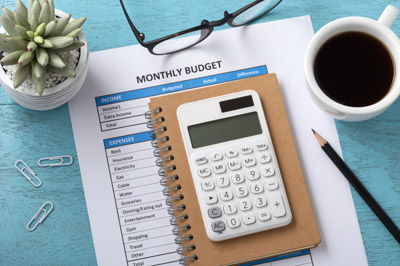Budgeting 101
 Whether you are a spender or a saver, one of the scariest words in the English language is the word BUDGET. Where do you start? Is it hard to make one? What’s it really meant to accomplish? More importantly, how do you stick to a budget?
Whether you are a spender or a saver, one of the scariest words in the English language is the word BUDGET. Where do you start? Is it hard to make one? What’s it really meant to accomplish? More importantly, how do you stick to a budget?
First, take a deep breath and know that there is nothing scarier than not knowing what happens to all your money. Your budget is just a tool to help you determine where your money goes. It’s that simple.
The best way to get started is to work on one month at a time.
Before you begin
Choose your tools – You need to decide if you want your budget to be digital, say in a budgeting app or an Excel spreadsheet, or if you’re going old school with paper and pen. There’s no right answer to this. Some people prefer the pretty graphs and automated math features found in an app. Others find it grounding to sit down with a piece of paper and a calculator.
Gather documentation – To make an effective budget, you must know how much you make and how much you spend. So take the time to gather up all your bills including utilities, rent or mortgage, car payments, insurances, daycare bills, tuition payments, and anything else you pay. Do you have things that you pay less than monthly? You’ll need to plan for annual property taxes or quarterly car insurance too.
Getting Started
Make a list – Make a list of every bill you will pay this month, estimate the cost and add it all up. Now add up your income and take a long, hard look at how much money is left after you pay your bills.
Non-bills – What else do you buy each month? You will need groceries and gas for the car. Do you have a gym membership? What about clothes, movies, eating out and other fun purchases? Don’t forget about birthdays, vacations and holiday gifts. Make a list of everything you spend money on. Are there big purchases that you need to save for every month? Do you even know how much you spend on these things? Look back through your credit card and bank statements to get an honest feel for how much you’re really spending on these extras
Pay yourself –Saving money is important so don’t forget to save for retirement and emergencies. Most Americans are woefully unprepared for even a $500 emergency but tucking away a little each pay will help you be ready.
Add it up – Take a moment to add up all these bills, discretionary spending and saving. How does it look? Is your spending outpacing your income? Are you incurring credit card debt for clothes, dining out and vacations? This can be a sobering moment in the budgeting process and will determine your next steps.
The reckoning – How do you feel about what you’ve learned so far? Did you realize you were spending so much on food? Do you see room for cutting expenses? Are you pleased with where you are? For most first time budgeters, there is something shocking about this complete snapshot of their spending habits. Once you reach this point in the process, it may be time to go back and start making some edits.
Working the puzzle – Most Americans are living at or above their means. If this is the case for you, building an effective budget will be like working a puzzle. You may need to look at cutting some costs to make that puzzle fit together more easily.
Looking ahead – If you have large quarterly or annual expenses to plan for, it’s smart to look ahead and consider the best ways to do that. Often, the easiest thing is to budget a little every month and then use automatic transfers from your checking to savings so that you’re not bearing the burden all at once.
Every month – You will need a budget for every month. Eventually, you may find that it’s easy to simply copy last month’s budget with some small changes while other months require more work. It’s often most effective to budget an entire quarter at once so that you get a broader view of your needs.
The Hard Part
The hardest part to any budget is sticking to it. It’s easy to get carried away on vacation or to forget all about it when the kids need shoes. That’s why it’s important to check in with your budget before making purchases and to make needed adjustments. Remember, your budget isn’t carved in stone. It’s a living, breathing document that is most effective when it’s kept updated and when it’s used.
Are you ready to get started with a budget that will put your money to work for you? There’s no better time to start than today!
We also offer tips for sticking to a budget and ideas for saving money when you need to trim some costs.